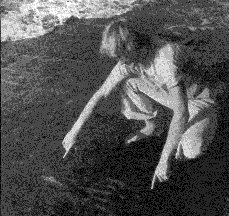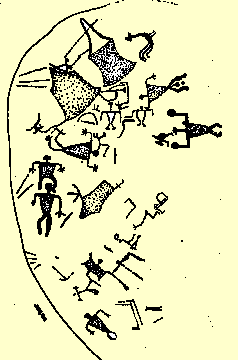
This Hawaiian saying in the title expresses the animistic sense of stone that has long enriched their culture. More than any other Polynesian sub-culture, to my knowledge, the Hawaiians have built upon their perception of stone. Stones were crucially concerned with the sovereignty of the land.
GENERAL INFORMATION
Petroglyphs have not been reported for Kauai in the abundance which marks the other Hawaiian Islands, though more may be discovered. At present stone glyphs have been found in four places and reported from a fifth. There are in all 168 figures representing chiefly human forms.
Applying the classification used by Emory for the Lanai petroglyphs it is apparent that most of the human figures are of the linear form, a few are triangular, and the columnar type is rare. Without showing individual drawings of each glyph, the varied combinations of head form, arm, and leg position, and special features, can not be given. (Bennett 1931:90)
The technique is seen to be chiefly a pecking one. The grooves are from 0.25 to 0.75 inches deep and from 0.5 to 1.5 inches wide. The figures range in height from 1 to 7 feet, being exceptional in this respect. (Bennett 1931:93).

In the human figures the typical head representation is round and solidly cut out and has no indication of facial features. Rarely the shape is oval. A few of the heads are round and outlined instead of solid. One of these a dot in the center of the outline possibly represents some facial feature.
In a few figures the head is represented by a vertical line, and on one by a horizontal line. Triangular and quadrangular outline head are depicted. In one of these triangular heads a dot in the center again seems to represent a facial feature and in one quadrangular head two dots are shown for eyes, a square U for a nose and a straight line mouth. Most of the heads are placed on short, straight necks, though some are on long necks, and some are placed directly on the shoulders. In a few figures the heads are completely detached from the body. Some figures are without heads (Bennett 1931:92).
Feet, like hands, are straight lines at angles to the legs. Dots at the end of the legs represent feet in a few figures. Two, three, and four toes are found, with three as typical. (Bennett 1931:93). Muscle delineation is not common. Triangular muscles were not noted (Bennett 1931:93).
Most of the arms are at right angles to the shoulders and extend downward. It is common to have only one section of the arm represented with a short hand attached to it, though in some figures two sections of the arm are depicted as well as a hand. Arms that slant downward and those that extend outward on the line of the shoulders, are found in places and in some figures one or both arms are raised. Although the arms are most commonly straight, curved lines are used. Arms are distorted in some figures and extend to lengths far beyond their proportions. Rarely the arms are missing. An extra pair of arms was noted for several figures, between the regular arms and legs (Bennett 1931:92).
Hands when delineated are in most figures short, straight lines at an angle to the arms. A knob is used in a few places. In many hands three fingers are shown, and less commonly, two or four. more than four were not observed on one hand. One figure has a triangular hand. (Bennett 1931:920.)
Shoulders are represented by straight lines, most of them horizontal, though some are oblique. The only variation is a slight curving which is probably due somewhat to poor technique. In some figures it is hard to distinquish arms and shoulders (Bennett 1931:92).
The legs are mostly straight (or slightly bowed) lines, though some definite curves are found.. The thigh is in most figures at right angles to the trunk , and the lower section of the leg slants down from this at varying angles. The position of some of the legs suggest running. In a few glyphs more than two legs are shown. (Bennett 1931:92-93).
A vertical, straight line represent the trunk in most figures. This is varied by the addition of six or more pairs of lines slanting downward from the vertical which possibly represent ribs or a skeleton. Triangular trunks are found and a few of these do not meet at the hips but continue into the legs. Some of these have the sides bulging out a little. One columnar trunk was noted and a few that were columnar from the waist down, including the thighs, the rest of the figure being linear. (Bennett 1931:92).
Sex when indicated is male. This is marked by the downward extension of the trunk line. (Bennett 1931:93).
Aside from the human figures other objects are shown. Animals are rare. In all the Kauai glyphs the cow and dogs found by Emory on Lanai were not seen. A canoe is shown in one place with a man above it. No sail is indicated. Many of the miscellaneous lines may be incomplete figures and some are completely unrecognizable. Others are definitely geometric or the depiction of some material object. (Bennett 1931:93).
KONA DISTRICT
Waimea: Waimea Valley On eastern face of cliff. petroglyphs plus several pictographs.
Hanapepe: Hanapepe Valley, KA-C1-18. A small boulder, 1 1/2 by 2 1/2 ft, found by Mr. Nonaka on his farm land, in upper Hanapepe Valley, now at Mr. Nonaka's home. An owl-like "face", pecked. (Cox, Stasack 1970:89).
Hanapepe:Wahi-awa Valley, KA-B7-6 Two areas: cliff on west side of Wahiawa stream approx. 2 miles from at 280 ft. elev. ; on east side of stream, across from the above site, approx. 500 ft from stream bed. Linear, angular human figures-lettering-names-dates (1883,1887). +/- 40 units, ( Kikuchi, 1963,sites 9,10,11; Cox, Stasack 1970:89) Wahiawa gulch about one-half mile below the government road where one glyph has been reported by Judge Lyle A. Dickey. (Bennett 1931:90).

Koloa: Keoneloa, KA-B2-1. Beach ledge 25 by 100 feet, sandstone, approximately 3/4 mile east of Makahu'ena Point, southernmost tip of island. Human figures, mostly linear; some are large, some ribbed, columnar, triangular-boat (?)-"Lono" symbols. +/- 168 units. (Farley 1898:119-125, Judd 1904:178,Stokes,ms BPBM, Bennett 1931 :90, Cox, Stasack 1970:89).O
ne shown in figure 17p represent skeletons or dead (A famous burial dune is near this beach). The immense size of the glyphs is hard to explain except as a sign of power. Little can be added as yet to the interpretation of the glyphs made by Emory. (Bennett 1931:94)
As the ledge on which the pictures are made is, when free of sand, only partly exposed at low tide, and then nearly covered with water by every good sized wave, a natural conclusion is that the beach has subsided at least 6 feet since the pictures were cut....The upper half of the ledge was dark and well glazed over, and the gravings on it were worn to the same appearance.
Farley quotes the unverified statement of Kauila, an old Hawaiian woman, who said: another ledge from fifty to one hundred feet further inland, under the sand, has pictures of birds, fishes, canoe and strange animals cut on it. The animals are not like anything now seen; they have bodies like cattle, heads and ears like pigs, but no horns; canoe has no outrigger or figures in it (Farley 1898< Bennett 1931; 93). Site 84 (Bennett 1931:90).
The pictured ledge of Keoneloa has been long famous. It was described by Farley in 1898, and again by Judd in 1904. The beach is about one- half mile in length and the ledge itself is about 110 by 25 feet. It is usually covered by sand except after heavy storms. (Bennett 1931 90). The Keoneloa glyphs are located on a sandstone ledge along the beach, and most of the figures have their heads towards the ocean. Most of the reported glyphs from elsewhere in the Hawaiian islands are on rocks and in caves.
The beach where the glyphs are located is a fine landing place. that the glyphs were cut as a record of the start and completion of journeys is possible. The presence of the canoe glyph seems to confirm this idea. Stokes suggests that figures like the one shown in figure 17p represent skeletons or dead (A famous burial dune is near this beach). The immense size of the glyphs is hard to explain except as a sign of power. Little can be added as yet to the interpretation of the glyphs made by Emory. (Bennett 1931:94)

Maha'ulepu: Maha'ulepu Valley, KA-B1-6 Boulder in a cane field approximately 2 miles inland. Groove to a large cup hole-linear figures +/- 20 units (Kikuchi 1963,site 103,1040. Cox Stasack 1970:89).
Maha'ulepu:Shoreline Beachrock ledge fronting Gillin's house. Glyphs exposed only by high storm seas, otherwise covered with nearly 2-4 ft of sand. Glyphs are in perfect condition due to sand cover.
Makawehi Point:Makawehi Point, KA-B2-3 On sandstone rise approximately 1/4 mile east of Keoneloa site B2-1 at east point of bay. geometric grid patterns-lines +/- 4 units (Kikuchi 1963,site 101,Cox, Stasack 1970:89).
Lawa'i: Lawa'i Valley, KA-B5-3 Boulder-cliff outcropping, on James Marques property, Iwipoo rd, Linear human figures,+/- 20 units1 Bennett 1931:90,site 71, Cox,stasack 1970:89). The petroglyphs on the large rock in Lawai valley (site 71), are made chiefly with the abrading process of hammering and rubbing described by Emory. A dozen figures were visible of which all but two were finished linear representations of human figures.
The two unfinished figures represented the body and legs without head or arms; and the head and trunk without limbs. The others have round solid heads on short necks or on the shoulders themselves. The shoulders are straight and the arms slant downward. In all, quite regular, linear type petroglyphs. Their heights are all less than a foot. (Bennett 1931:90).
PUNA DISTRICT
Kipu-Kai: Molehu KA-A6-4 On limestone beach, approx. 1/2 mile north of Lihue-Koloa boundary. Linear angular human figures, one triangular muscled, one curvilinear-circles. +/- 25 units. (Stokes 1910, Cox, Stasack 1970:89)
Nawiliwili Harbor:, Papalinahoa, KA-A3-6. Sandstone ledge on north shore of Nawiliwili Harbor. Believed destroyed when pier was constructed. Human figures, +/- 5 units. (Bennett 1931:90,Cox, Stasack 1970:89) Those at Papalinahoa, Nawiliwili, are the closest in size and technique, (in reference to the pecking manufacture of the glyphs) (Bennett 1931:93).
The five figures from the rocks of Papalinahoa described by Stokes are linear with the possible exception of one outlined triangular body, not joined at the hips. Three have round, solid heads on short necks and the other two are without heads. Two are armless; two have the arms slanting down; and one has the left arm up. One has a solid body that bulges out above the legs. All five are about 1 foot in height. (Bennett 1931:90).

Wailua:, Ka-pae-ki'i-mahu-o-Wailua, KA-A1-6. Boulders on shore near the northern boundary of Lihue district, south side of mouth of Wailua river. Human figures, linear and curved outline-spiral (the only one known in the islands).. +/- 16 units. (Dickey 1917,; Cox, Stasack 1970:89).
Niu Ridge: where glyphs are reported to have been located. (Bennett 1931:90).